Financial Freedom Update Sept 2021 – Market Highs Edition
Welcome to the Million Dollar Journey September 2021 Financial Freedom Update – Market Highs Edition! If you would like to follow my whole financial journey, you can get my updates sent directly to your email, via Twitter and/or Facebook.
For those of you new here, since achieving $1M in net worth in June 2014 (age 35), I have shifted my focus to achieving financial independence. How? I plan on building my passive income sources to the point where they are enough to cover our family expenses.
Here is a little more detail on our passive income goals:
How it all started – Original Financial Goal
Our current annual recurring expenses are in the $52-$54k range (after-tax), but that’s without vacation costs (and no mortgage payments). However, while travel is important to us, it is something that we consider discretionary (and frankly, a luxury). If money ever becomes tight, we could cut vacation for the year. In light of this, our ultimate goal for passive income is to have enough to cover recurring expenses, and for business (or other active) income to cover luxuries such as travel, savings for a new/used car, and simply extra cash flow.
Major Financial Goal: To generate $60,000/year (after-tax) in passive income by end of the year 2020 (age 41).
Reaching this goal would mean that my family (2 adults and 2 children) could live comfortably without relying on full-time salaries (we are currently a one-income family). At that point, I would have the choice to leave full-time work and allow me to focus my efforts on other interests, hobbies, and entrepreneurial pursuits.
Achieving Financial Freedom: I’m happy to report that we reached financial independence in 2020 – a little ahead of schedule. While the goal now is to continue building and reinvesting those dividends within the portfolio I’m finding that as the years go by, more focus is being put on indexing. Having said that, I haven’t sold any dividend positions in favour of index ETFs… yet.
Since the last update, I’ve phased out of salaried work and for the first time since graduating from university, I’m without a steady paycheck. That is if you don’t count dividends flowing into the investment account. You can read my previous update on how I plan on managing financial risks in early retirement.
Financial Independence Update – September 2021
Equity markets continue to make all-time highs which is basically the theme of 2021. The S&P500 (an index of the largest 500 companies in the US) was floating around 4300 in the previous update a couple of months ago. This time around, it’s over 4500!
Not including dividends, the S&P500 has advanced about 35% and the TSX about 29% over the past 12 months. While the extreme market returns are great for portfolio growth, it would be healthy for the markets to take a bit of a break – especially for investors still in the early days of accumulation.
As you may know already, while I stay invested through thick and thin, I’m always a little cautious over a prolonged bull market. So I still expect that we’ll get some sort of pull-back to the long-term moving average in the coming months.
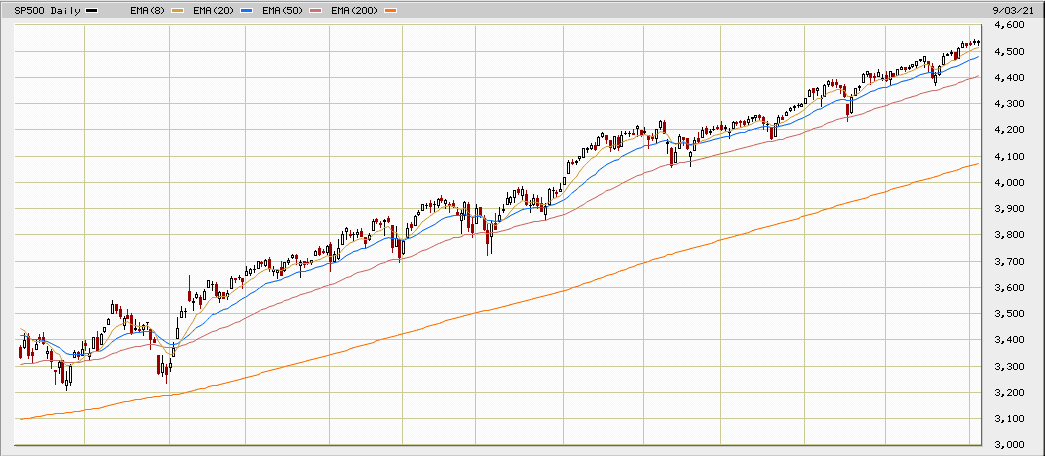
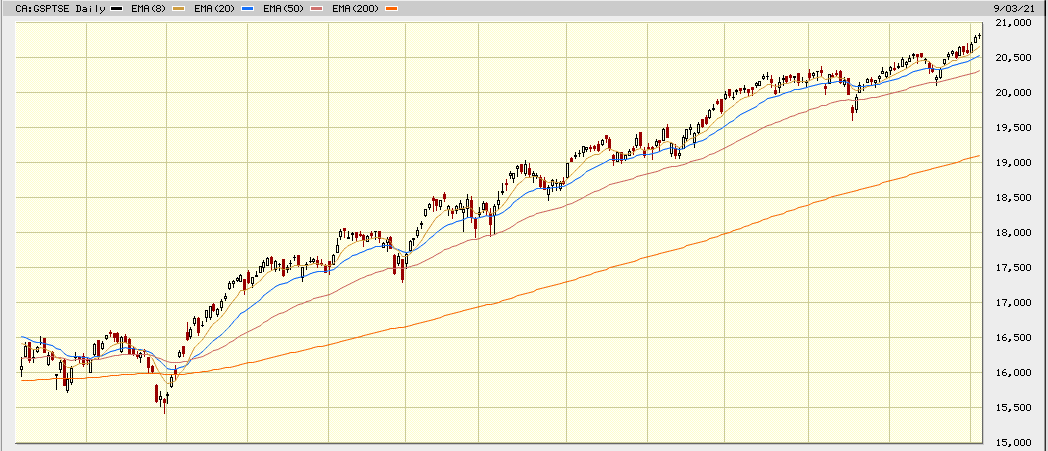
As I’ve mentioned in many other updates, I like to buy quality dividend companies (and indexes) when their valuations are attractive. In other words, when they are being sold off (ie. dip). You can see some of my favourite Canadian dividend stocks here.
Thus far in 2021, I have deployed capital into the following Canadian dividend positions:
- Waste Connections (WCN)
- Brookfield Infrastructure (BIP.UN/BIPC)
- Algonquin Power & Utilities (AQN)
- Canadian National Railway (CNR)
- Brookfield Renewable (BEPC)
The goal of the dividend growth strategy is to pick strong companies with a long track record of dividend increases. In terms of dividend increases, this year has proven to be lucrative for dividend growth investors thus far.
2021 Dividend Raises
So far in 2021, the Canadian portion of my portfolio received raises from:
- CU.TO (1% increase)
- MRU.TO (11.1% increase)
- CNR.TO (7% increase)
- XTC.TO (5.3% increase)
- BIP.UN/BIPC (5.2% increase)
- MG.TO (7.5% increase)
- CNQ.TO (11% increase)
- NTR.TO (2% increase)
- BCE.TO (5% increase)
- TRP.TO (7.4% increase)
- ENGH.TO (18.5% increase)
- AQN.TO (10% increase)
- T.TO (1.6% increase)
- H.TO (5% increase)
- EMP.TO (15% increase)
- FTT.TO (10% increase)
- WN.TO (9% increase)
- L.TO (9% increase)
- CPX.TO (6.8% increase)
- NWC.TO (2.8% increase)
I’m reading that the banks have excess capital and might significantly increase their dividends later this year – fingers crossed!
Top 10 Holdings
Our top 10 holdings move around quite a bit. In the previous update, the big banks were the top 5 positions, but due to a recent big move by CNR, it has launched back into the number 1 spot.
In our overall portfolio, here are the current top 10 largest dividend holdings:
- Canadian National Railway (CNR)
- CIBC (CM)
- TD Bank (TD)
- Royal Bank (RY)
- Bank of Montreal (BMO)
- Fortis (FTS)
- Scotia Bank (BNS)
- Emera (EMA)
- Enbridge (ENB)
- Brookfield Infrastructure (BIPC/BIP.UN)
*not counting index ETFs (they are my largest holding).
Dividend Income Update
As mentioned, there have been a number of healthy dividend increases and we managed to deploy some capital into dividend stocks.
As you can see in detail below, we have slightly increased our annual dividend income to $63,580. While it’s a small increase, I’m happy to accept what I can get!
Here are the numbers.
September 2021 Dividend Income Update
| Account | Dividends/year | Yield |
| Smith Manoeuvre Portfolio | $7,880 | 3.49% |
| TFSA 1 | $4,300 | 3.79% |
| TFSA 2 | $4,000 | 3.70% |
| Non-Registered | $4,300 | 3.92% |
| Corporate Portfolio | $31,650 | 3.09% |
| RRSP 1 | $7,900 | 2.29% |
| RRSP 2 | $3,550 | 1.91% |
- Total Yield: 3.01%
- Total Dividends: $63,580/year
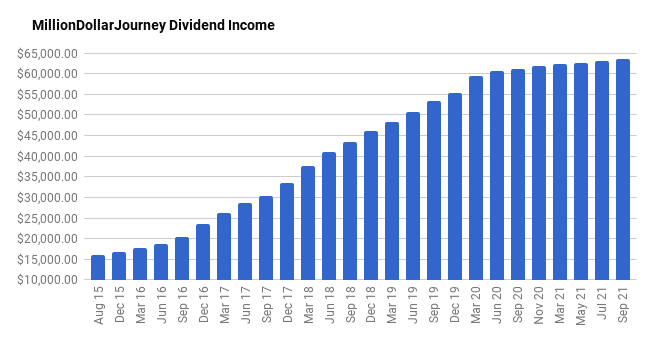
Final Thoughts
With markets continuing to make all-time highs resulting in growing portfolios, investors who are still accumulating should continue doing that – accumulate. However, for those living off their portfolio, or those that need to withdraw from a portfolio soon, (like RRSP or RESP), are you prepared for the next market correction? Do you have the cash you “need” in the near future readily accessible in some sort of fixed-income investment (HISA, GICs, bonds etc)?
Thankfully, dividends, for the most part, continue to flow regardless of market conditions – which is one of the major reasons why I like dividend income for early retirees.
I’ve noticed that other dividend investors/bloggers are comparing their dividend income to a comparable income/hr. Depending on taxation in your area, in ON, $63.5k in dividend income is about equivalent to an $85.5k salary, which is about $42.75/hr. Not a bad way to psychologically frame passive income.
To put dividend income in further context, I wrote a post about withdrawing from your RRSP or TFSA where, with no other income in retirement you can make up to $50k in dividend income (within a taxable investment account) and pay very little to no income tax (depending on the province).
If you are also interested in the dividend growth strategy, here is a post on how to build a dividend portfolio. With this list, you’ll get a general idea of the names that I’ve been adding to my portfolios.
If you want a simpler investing strategy that outperforms most mutual funds out there, check out my post on the best all-in-one ETFs in Canada. I’m a fan of indexing as the iShares XAW is my top individual holding.
Keep investing that cash flow and stick with a long-term plan. Your future wealthier self (sooner than you think!) will thank you for it.
I've Completed My Million Dollar Journey. Let Me Guide You Through Yours!
Sign up below to get a copy of our free eBook: Can I Retire Yet?


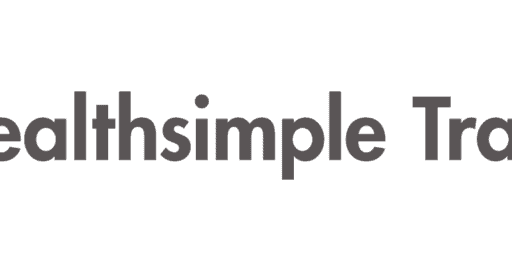
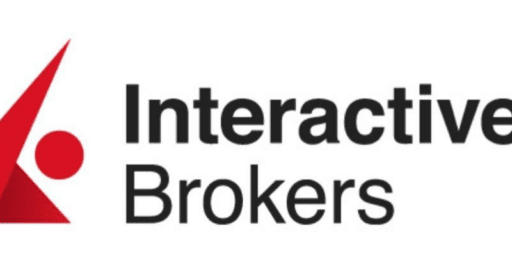






That is a comfortable number (your dividends) for a family of 4 to live happily in Canada! Congratulations!
Yes, the markets are high but my understanding is that the dividends stocks don’t track the markets 1:1 because the gain is harvested as dividends? Or do dividends stock (holders) get to harvest the dividends and at the same time gain in values that reflects the market (TSX, S&P)?
Good stuff. About half of my retirement investment income comes from real estate, with the rest coming from stock dividends, bonds, and passive income from my severance negotiation book.
it is crazy how high the bull market has gotten for stocks and real estate. We are also a family of 4, but in higher cost San Francisco.
As a result, we’d like to live off $240,000 a year after tax as my wife doesn’t work either anymore (2015 for her, 2012 for me).
Sam